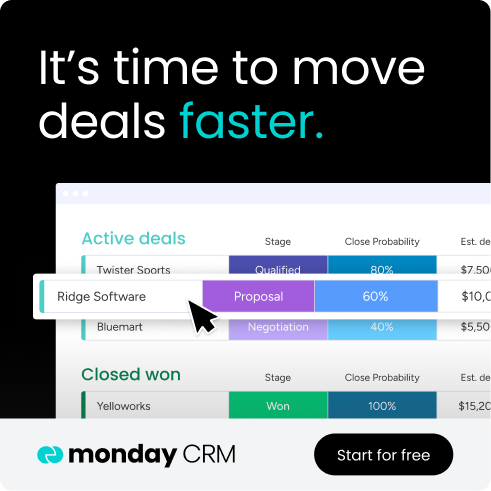Great sales teams don’t just track numbers: they understand them. The difference between hitting a quota and missing it often lies in seeing what the data is really saying: where deals stall, which reps need support, and what actions lead to growth.
Modern sales analytics software turns that complexity into clarity. It connects every interaction, from calls to conversions, into a complete view of performance so your team always knows where to focus next. Insights that once took days to uncover now appear instantly, guiding smarter decisions and faster wins.
As technology reshapes how teams sell, the right platform can become your competitive edge. Below, we explore the leading sales analytics tools of 2026 and what sets them apart — helping you choose a system that drives both visibility and results.
Key takeaways
- Turn scattered data into a single source of truth: unify sales data from calls, emails, and deals in one workspace so everyone acts on the same insights, not conflicting reports.
- Shift from hindsight to foresight: move beyond looking at past results — modern analytics predict what’s ahead, highlighting trends and risks before they impact your targets.
- Automate the busywork: let your software handle data pulls, scoring, and tracking so your sellers can spend more time where it counts—building relationships and closing deals.
- See your pipeline in full color: real-time visibility replaces guesswork, revealing exactly where deals stall and where to focus coaching and support.
- Work as one team with monday CRM: connect your sales data, workflows, and performance tracking in one flexible platform, aligning sales, marketing, and operations around shared goals.
What is sales analytics software?
Sales analytics software centralizes your team’s disparate sales data, transforming it from a complex array of numbers into a direct, actionable strategy for your entire revenue team. This process is fundamental to shifting from reactive decision-making to proactive growth.
Rather than merely reviewing past performance, these platforms provide predictive insights into future trends. They offer the strategic foresight needed to navigate challenges, identify emerging opportunities, and close deals with greater confidence, allowing your team to lead the market instead of reacting to it.
The platform’s core value emerges from its ability to connect every email, meeting, and customer interaction, revealing the complete narrative of a deal. Advanced systems like monday CRM automate this complex analysis, liberating your team to concentrate on building relationships and executing on intelligent insights, rather than manually searching for them.
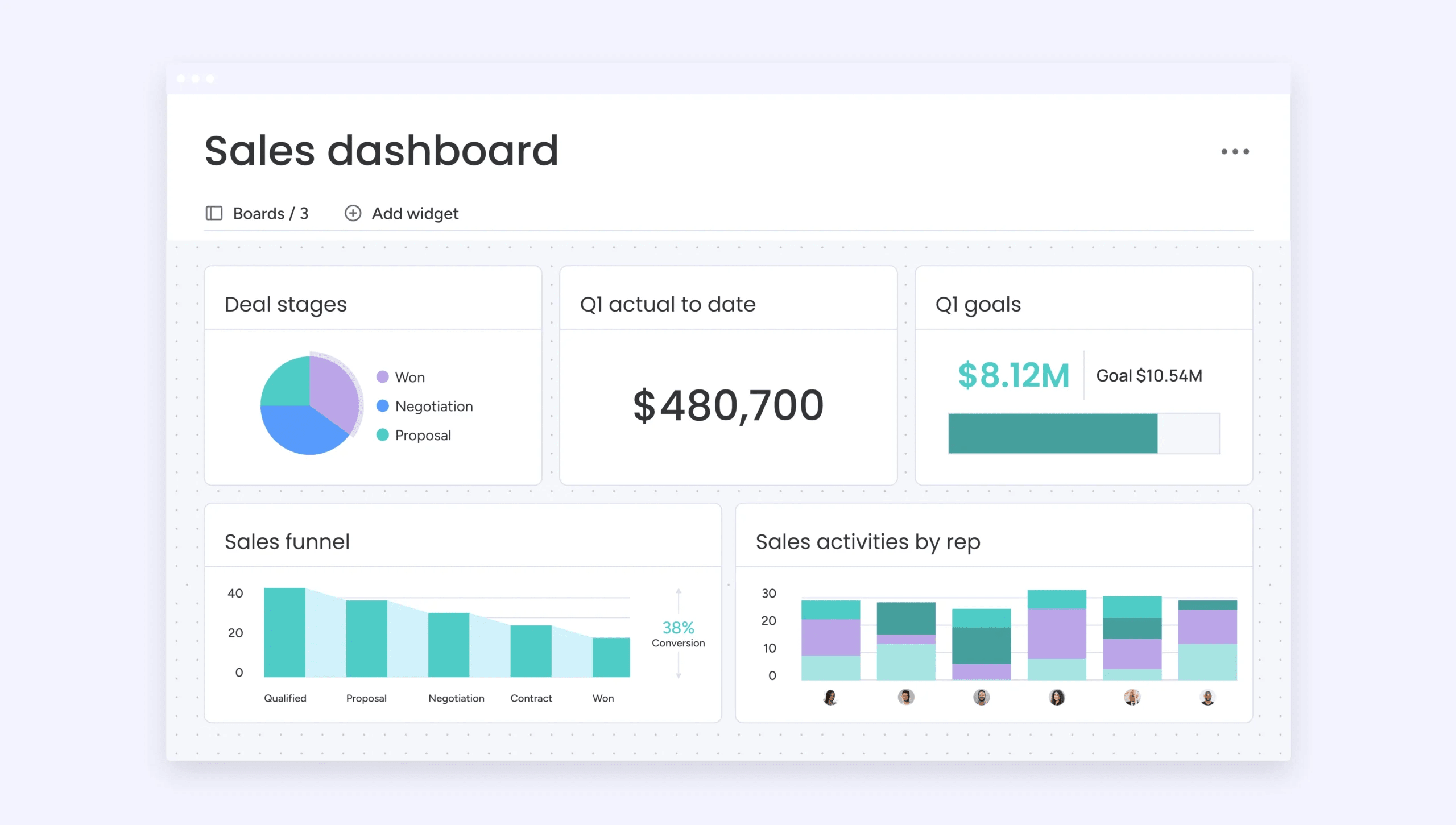
5 ways sales analytics platforms boost performance
Effective sales analytics go beyond simple reports to provide the entire team with a strategic advantage. By offering a clear, real-time view of the sales pipeline, analytics enable a crucial shift from guesswork to precise strategy, instantly highlighting opportunities. This capability ensures every action drives revenue.
- Eliminate guesswork: to allow for precise strategy by instantly highlighting bottlenecks and opportunities in the sales pipeline for targeted coaching.
- Targeted coaching: to focus management on impactful activities, effectively eliminating end-of-quarter surprises and improving team results.
- Free up sellers: to automate administrative tasks and cumbersome manual work, allowing top sellers to dedicate their time to closing deals.
- Improve forecasting: to leverage predictive insights for forecasting, resulting in a more accurate forecast and a sales team unburdened by spreadsheets.
- Build unified force: to ensure every team member operates from the same information, turning fragmented efforts into a powerful, unified sales engine with unstoppable momentum.
How to choose the right sales analytics solution
Selecting a new sales analytics tool is a critical decision that extends beyond simply adding to your tech stack. The right platform is an investment in predictable revenue and team clarity. An optimal solution integrates seamlessly into daily workflows, simplifying processes and surfacing opportunities without introducing new complexities.
The right platform is also an investment in predictable revenue and team alignment, integrating seamlessly into daily workflows to surface opportunities without introducing new complexities.
Follow the steps below and you will discover a straightforward approach to finding a solution that your team will not only adopt but also champion:
Step 1: assess your needs and goals
Start your selection process by closely analyzing your current sales operation to pinpoint its specific friction points. You need to identify precisely where efficiency is lost, whether it’s due to inaccurate forecasts, deals slipping through the cracks, or sales representatives being burdened by manual reporting. These identified weaknesses will form the essential blueprint for your platform’s must-have features.
Be realistic about your team’s current capabilities and scale. A nimble five-person team requires a different set of tools than a fifty-person revenue engine, so focus on choosing a solution that delivers immediate value but still offers ample room to grow alongside your business.
Step 2: check integration and user-friendliness
Your new platform must connect seamlessly with the systems your team already uses, especially your CRM. Look for platforms that unifies CRM and analytics, ensuring you eliminate data silos and achieve a central source of truth across the organization.
Even the most robust features are useless if your team finds the platform confusing or clunky. Therefore, prioritize a clean, intuitive interface that focuses on helping reps close deals, rather than making them navigate dense menus. Without this clarity, customer adoption will fail quickly.
Step 3: evaluate AI and automation capabilities
Prioritize platforms with intelligent, AI-driven features that function as a co-pilot for your sales team. The right platform will automatically flag at-risk deals and surface hidden opportunities, turning your data into proactive coaching moments.
Automation is a powerful tool for giving your team back their most valuable resource: time. By automating tasks like pipeline updates and lead scoring, you not only boost efficiency but also empower your reps to focus entirely on selling.
Step 4: compare pricing and support
Evaluate the total cost of ownership, which includes subscription price as well as implementation, training, and potential consultant fees. The best value comes from a platform your team can adopt quickly without needing expensive consultants or extra IT overhead.
When you are chasing revenue targets, delays are unacceptable. Partner with a provider that offers a dedicated customer success team which will act as an extension of your own crew, ensuring you hit the ground running and stay efficiently on track.
Step 5: plan your launch and adoption
A successful implementation requires a strategic launch plan. Clearly communicate how the new platform helps everyone win, from reps closing deals faster to managers getting the visibility they need to lead effectively.
Roll out the platform in phases, creating internal champions who can help build momentum and support their teammates. Remember, a successful launch is not a one-time event but rather about continuous support and optimization that helps your team keep winning.
The best sales analytics software platforms
Selecting the right sales analytics platform is a strategic choice that requires careful consideration. The objective is not merely to accumulate features but to find a system that illuminates the pipeline, empowers the team with usable data, and adapts to your evolving strategy.
Below we’ve lined up the top players to help your team evaluate the options and make a confident call. Each platform has its strengths, from heavyweight enterprise solutions to simpler, more streamlined tools.
Our goal is to help you find the perfect fit for your team’s unique rhythm and goals.
| Platform | Best for | Key features | Starting price | AI capabilities |
|---|---|---|---|---|
| monday CRM | Intuitive, adaptable solution | No-code customization, AI blocks, integrations | $10/user/mo | Sentiment analysis, lead scoring, AI insights |
| Salesforce Sales Cloud | Large enterprises | Advanced customization, Einstein AI, analytics | $25/user/mo | Predictive analytics, opportunity scoring |
| HubSpot Sales Hub | Growing businesses | All-in-one sales/marketing, free tier, automation | Free/$20/user/mo | Forecasting, automated insights |
| Zoho CRM | Affordability, feature-rich | Zia AI assistant, business suite integration | $14/user/mo | AI assistant, workflow automation |
| Pipedrive | Simplicity, visual pipelines | Visual pipeline, automation, reporting | $14/user/mo | AI sales assistant, deal insights |
1. monday CRM
monday CRM helps sales teams get organized and make smarter decisions by blending intuitive customization with helpful AI features. Built on the flexible monday Work OS, it allows teams to design the exact workflows they need without getting bogged down by complex software. This gives managers a clear view of the pipeline while letting reps focus on what they do best — building relationships and closing deals.
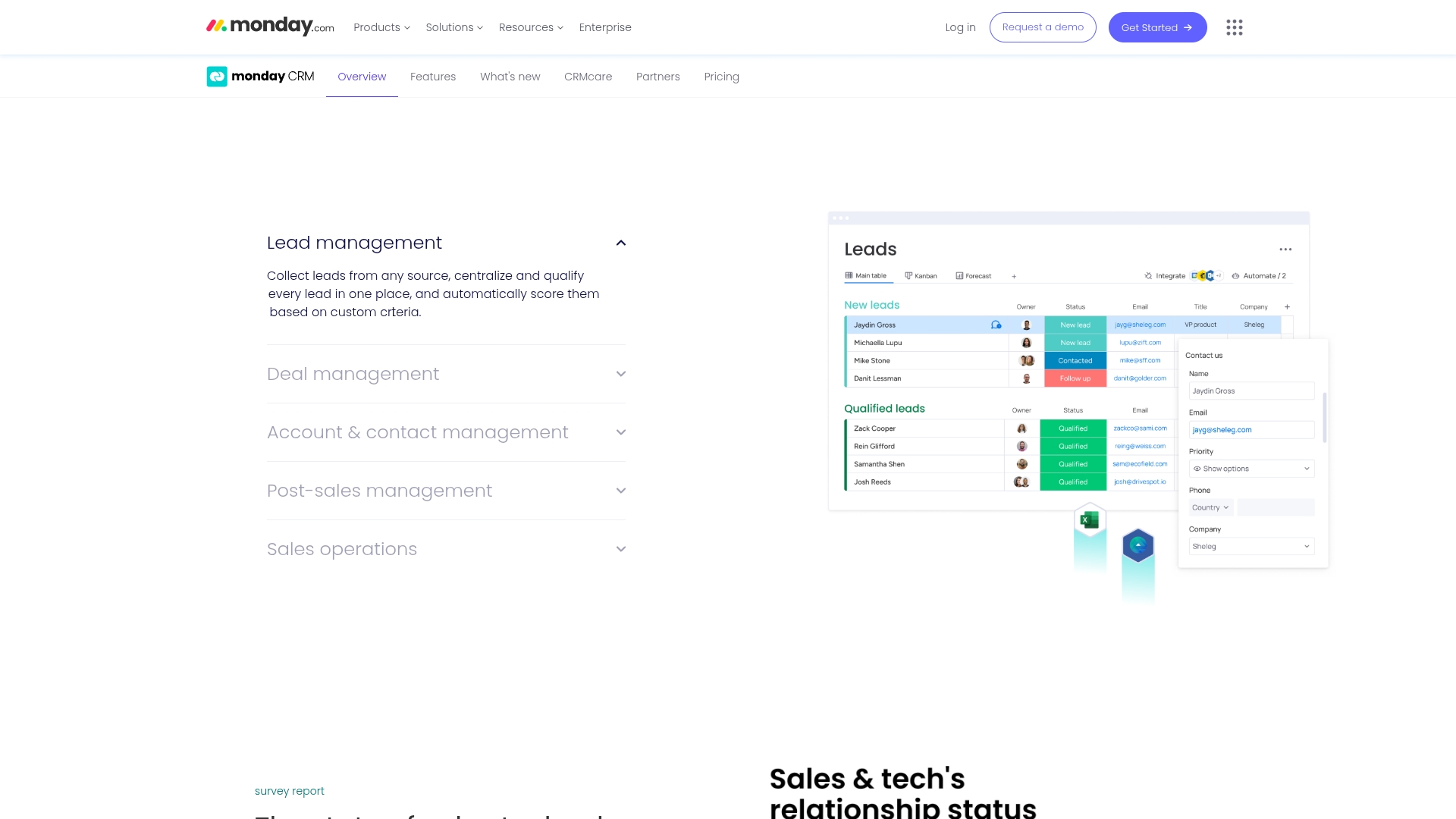
Example: by bringing all your sales information into one centralized location, monday CRM helps break down data silos. The platform uses automations and AI features to help teams spot trends, make data-informed decisions, and work more efficiently toward their revenue goals
Key features:
- AI-powered tools for lead scoring and sentiment analysis to help prioritize efforts and understand customer interactions.
- Customizable dashboards with 25+ widgets that visualize pipeline health, team performance, and revenue forecasts in real-time.
- Automations to reduce manual data entry, with integrations that sync information from tools like Gmail and Outlook to keep customer records up-to-date.
Pricing:
- Free: $0 (up to two seats, three boards, 200+ templates).
- Basic: $9/user/month (billed annually).
- Standard: $12/month per seat (billed annually).
- Pro: $19/month per seat (billed annually).
- Enterprise: custom pricing.
- Minimum requirements: three users.
- Monthly billing: available at a higher rate.
- Nonprofit discounts: available.
Why it stands out:
- The Work OS foundation allows sales teams to customize analytics workflows without coding or IT support.
- Helpful AI tools assist with tasks like summarizing text and categorizing leads, freeing up time for reps to focus on selling.
- Seamless integration with existing sales tools creates a single source of truth while maintaining familiar workflows.
2. Salesforce Sales Cloud
Salesforce Sales Cloud provides an enterprise-grade CRM and sales analytics solution for organizations managing complex sales processes. The platform specializes in AI-powered predictive insights through Einstein Analytics, making it ideal for large teams that need deep customization and comprehensive revenue intelligence.
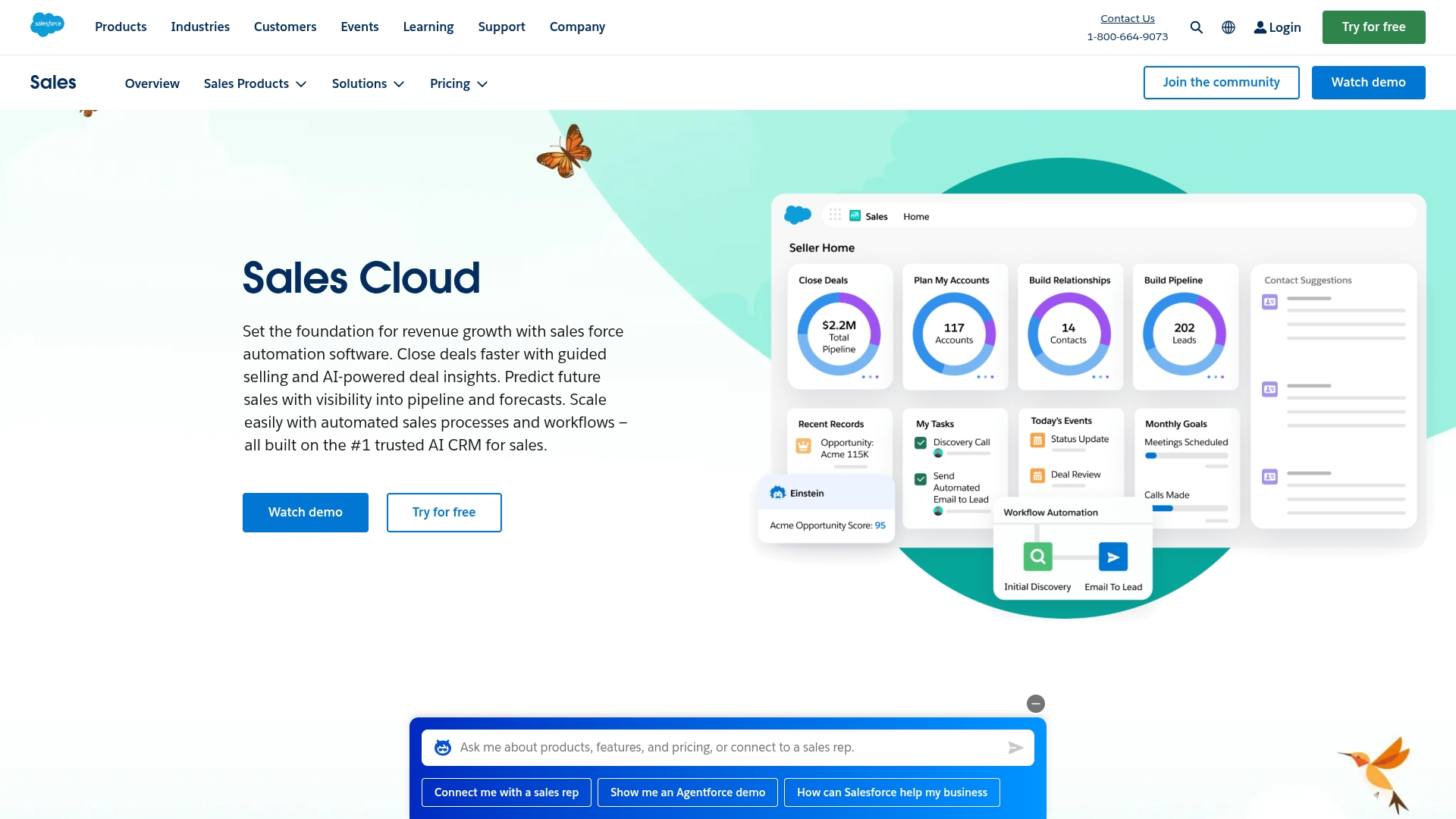
Example: Salesforce Sales Cloud provides unified sales analytics that combine forecasting, pipeline inspection, and revenue intelligence to help enterprise sales teams predict outcomes and accelerate deal closure.
Key features:
- Predictive forecasting: to utilize customizable categories and AI-powered opportunity scoring for highly accurate future predictions.
- Pipeline inspection: to provide unified dashboards, risk alerts, and deal prioritization tools for proactive pipeline management.
- Revenue intelligence: to offer dashboards with trend analysis, account health monitoring, and scenario planning for strategic decision-making.
Pricing:
- Several pricing tiers: including Starter, Professional, Enterprise, and Unlimited.
- Pricing information: visit the official Salesforce pricing page.
- Higher-tier plans: include more advanced features, and some capabilities like CRM.
- Analytics: available as add-ons for an additional fee.
Considerations:
- Steep learning curve: due to the platform’s overall complexity and extensive customization options.
- Higher total cost: due to factoring in required add-ons and costs for implementation services, leading to a higher total cost of ownership (TCO).
3. HubSpot Sales Hub
HubSpot Sales Hub offers comprehensive sales analytics within an all-in-one CRM platform designed to grow with your business. The platform excels at seamless integration between marketing, sales, and service data, making it a strong choice for teams seeking unified customer insights without the complexity of multiple disconnected tools.
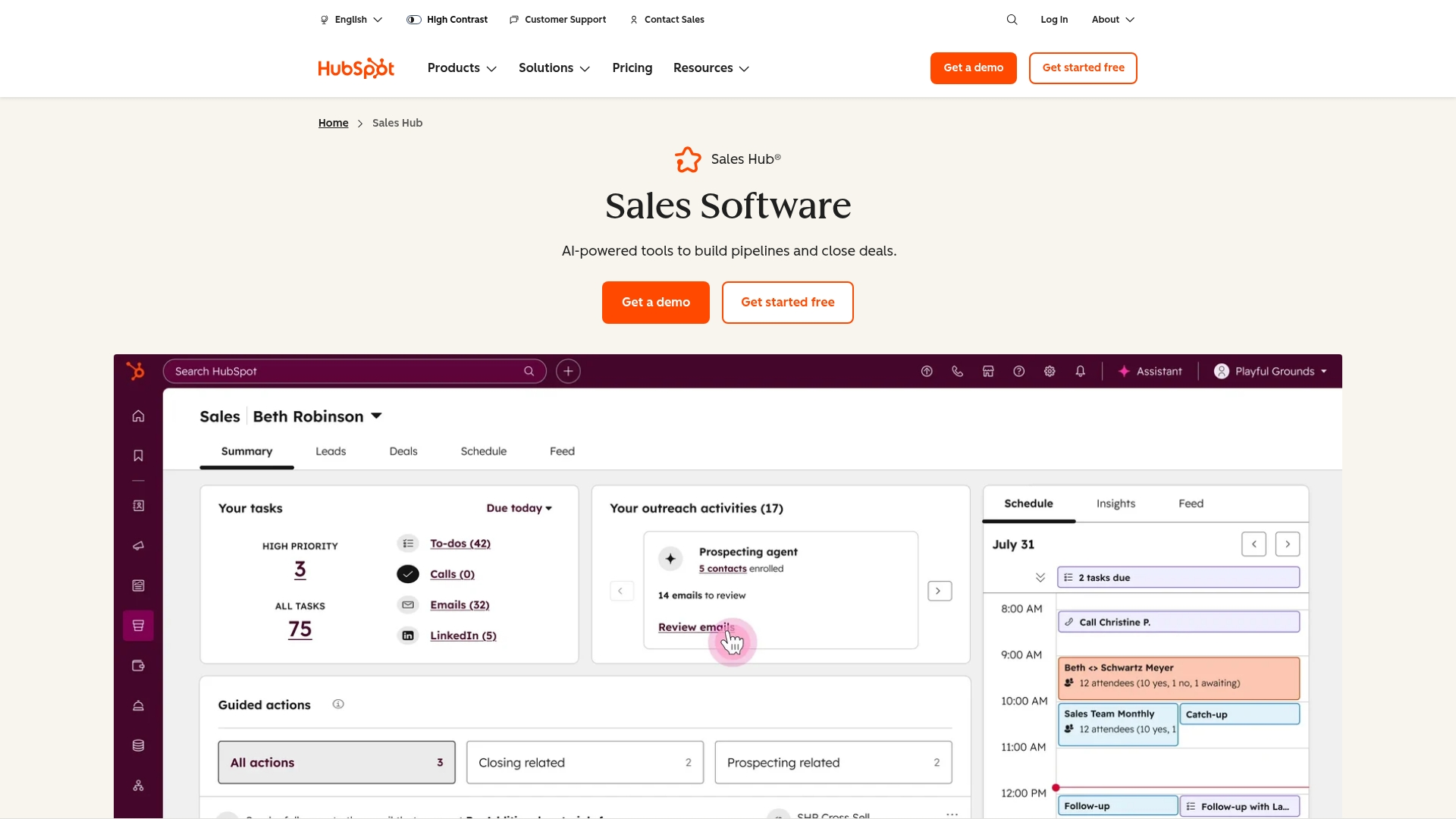
Example: HubSpot Sales Hub provides real-time sales analytics and performance insights through an integrated CRM that connects marketing, sales, and service data for complete customer visibility.
Key features:
- Customizable reporting: to utilize pre-built and customizable reports with AI-powered insights for deal forecasting, pipeline analysis, and sales activity tracking.
- Real-time monitoring: to provide performance dashboards that monitor team productivity, conversion rates, and revenue targets without requiring technical expertise.
- Integrated coaching: to leverage integrated sales coaching tools that identify top performers and provide actionable insights for improving underperforming reps.
Pricing:
- Several tiers: including a free plan with basic CRM features and paid plans (Starter, Professional, and Enterprise) that scale with your needs.
- Pricing information: visit the official HubSpot website.
Considerations:
- Feature limitations: advanced analytics features, such as predictive lead scoring and custom reporting, are only available in the higher-tier Professional and Enterprise plans.
- Reporting complexity: while the platform excels at ease of use overall, creating highly customized reports can become complex compared to using specialized analytics tools.
4. Zoho CRM
Zoho CRM combines its core functions with an integrated business intelligence platform, Zoho Analytics, and its AI-powered assistant, Zia. This pairing delivers powerful, affordable, and data-driven insights for small to medium-sized businesses that need robust analytics without enterprise-level complexity.
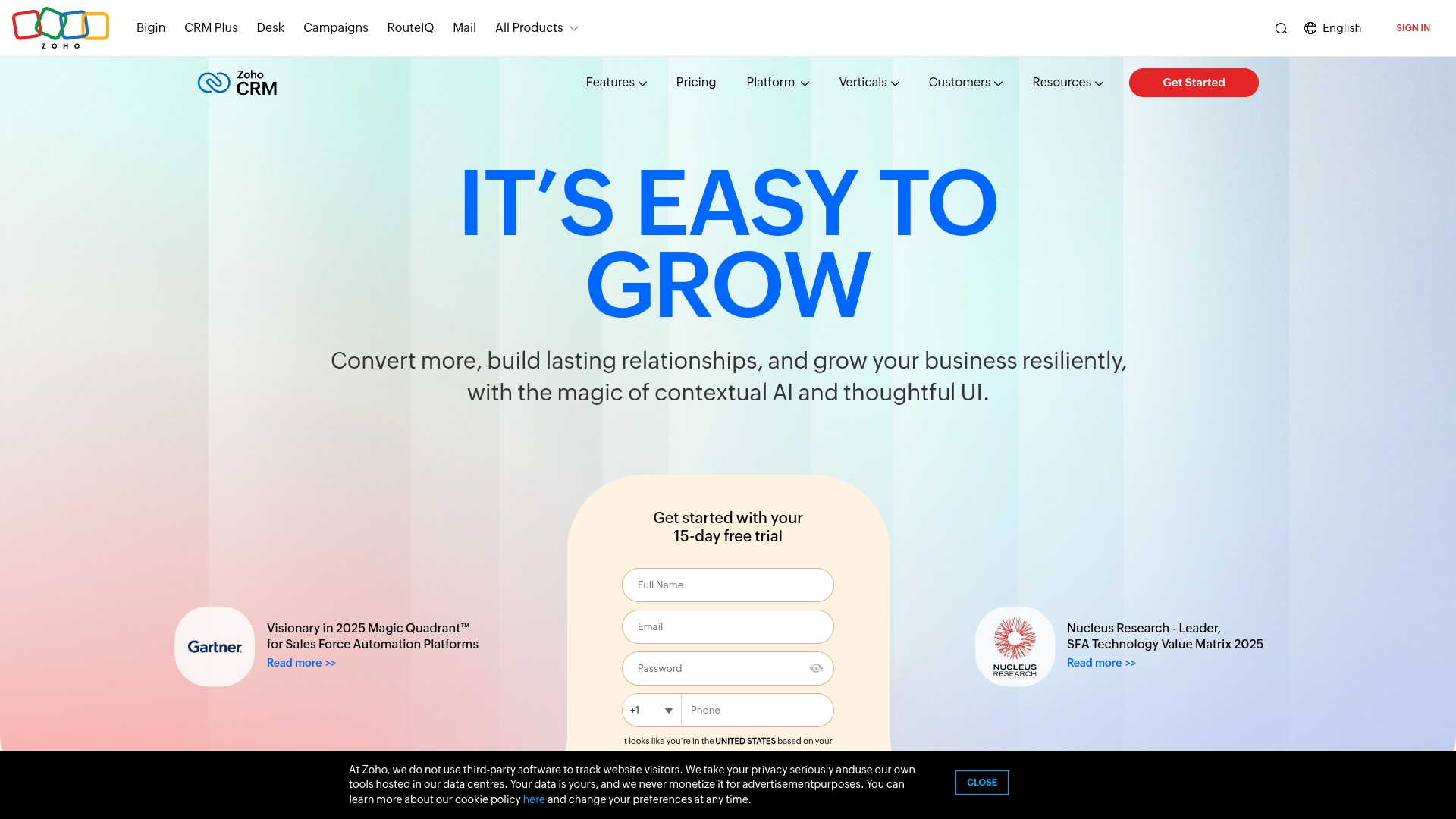
Example: Zoho CRM provides AI-powered sales analytics that help teams forecast performance, track key metrics, and optimize their sales processes through customizable dashboards and predictive insights.
Key features:
- AI-Powered assistance: utilizing the AI assistant Zia for predictive analytics, sales forecasting, and natural language query capabilities.
- Instant analysis: to access over 75 pre-built reports and dashboards through Zoho Analytics, featuring drill-down functionality for immediate data review.
- Centralized reporting: to use Zoho Analytics to import data from external sources, including other CRMs like Salesforce, HubSpot, and Microsoft Dynamics.
Pricing:
- Free Edition: for up to three users.
- Standard: $20/user/month (billed monthly) or $14/user/month (billed annually).
- Professional: $35/user/month (billed monthly) or $23/user/month (billed annually).
- Enterprise: $50/user/month (billed monthly) or $40/user/month (billed annually).
- 15-day free trial: available for paid plans.
Considerations:
- Feature limitations in free tier: the free edition lacks advanced analytics features, such as sales forecasting.
- Performance and interface: performance can slow with large datasets, and some customers report a cluttered interface.
5. Pipedrive
Pipedrive approaches sales pipeline management with a visual, activity-based methodology that keeps teams focused on the actions that close deals. The platform’s emphasis on simplicity and intuitive design makes it ideal for small to medium businesses that want powerful sales analytics without the complexity of enterprise-level solutions.
Example: Pipedrive helps sales teams visualize their entire sales process while providing real-time insights and forecasting tools to optimize performance and identify bottlenecks before they impact revenue.
Key features:
- Customizable tracking: to use dashboards and reports that track everything from deal progression to team performance metrics.
- AI-Powered forecasting: to predict revenue based on historical data, with an AI Sales Assistant offering insights and recommendations.
- Mobile access: to provide sales reps with key performance data on the go via the mobile app access to dashboards and reports.
Pricing:
- Lite: $14/month per user (billed annually).
- Growth: $39/month per user (billed annually).
- Premium: $49/month per user (billed annually).
- Ultimate: $79/month per user (billed annually).
- 14-day free trial: available for all plans.
- Add-ons: available starting at $6.67/month per company.
Considerations:
- Feature limitations: advanced reporting features are limited in lower-tier plans, requiring upgrades for comprehensive analytics capabilities.
- Reporting inconsistencies: some customers report inconsistencies with email tracking analytics and limited filtering options for custom fields in reports.
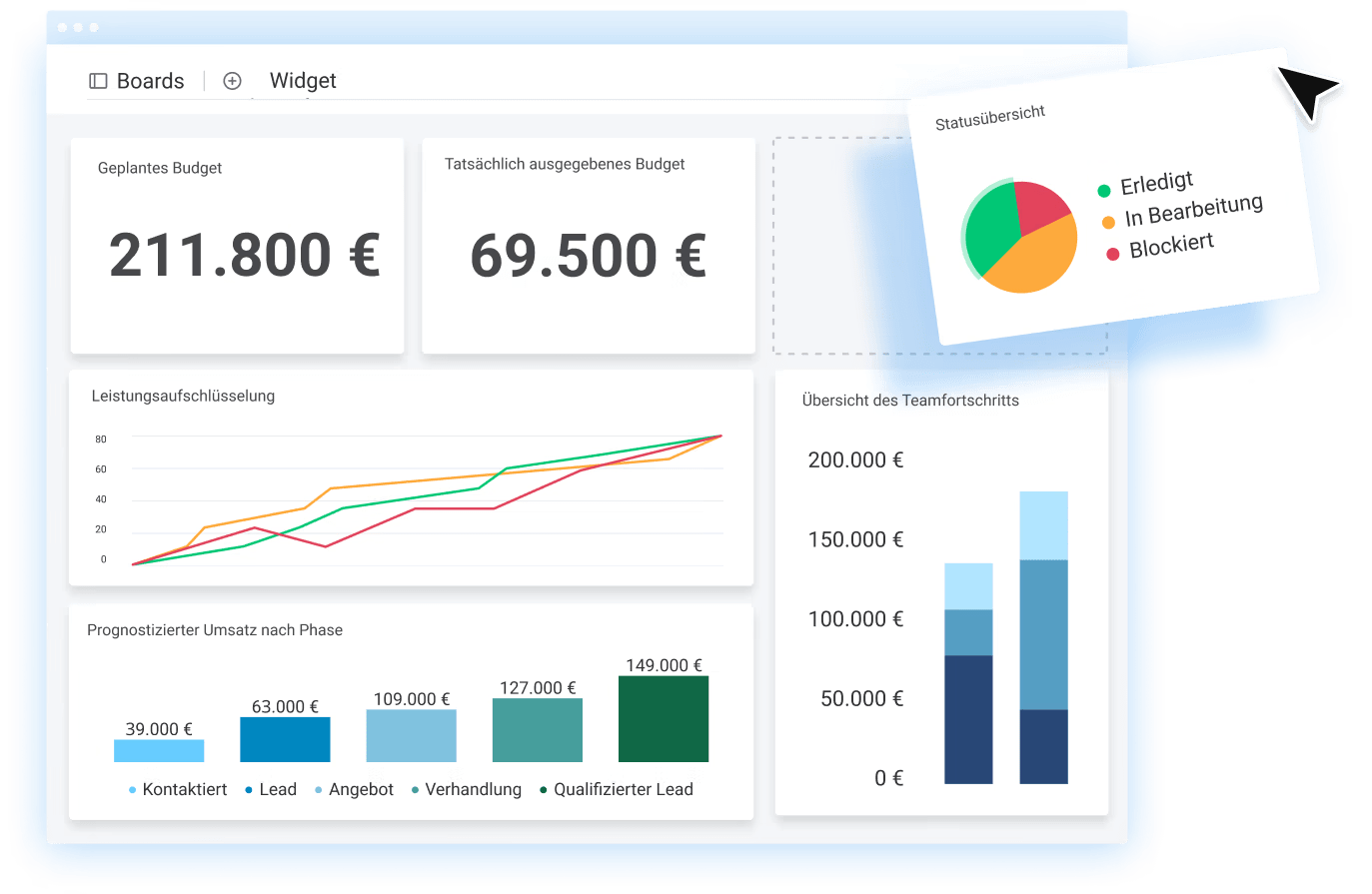
Overcoming challenges with analytics in sales
Implementing a sales analytics system presents common challenges, such as managing inconsistent data and overcoming team resistance to new processes. However, these obstacles are entirely manageable; they represent the very obstacles that, once overcome, unlock a more efficient and intelligent sales methodology.
When team members track deals differently, it becomes difficult to trust the data or accurately predict outcomes. Furthermore, asking people to adopt new workflows can be challenging, especially if the new system seems more complicated than existing methods.
A truly effective platform like monday CRM makes powerful analytics feel effortless instead of intimidating. It guides the team to capture the right data consistently, automates administrative work, and allows organizations to roll out changes at a pace that builds confidence, not friction.
Advanced sales analytics with AI-integrated features
Modern sales analytics should evolve beyond historical reporting to offer predictive capabilities. AI-powered features of platforms like monday CRM achieve this by transforming past data into a forward-looking strategy, enabling your team to focus on deals with the highest probability of closing. This proactive approach is a key competitive differentiator.
Integrated AI functions as a valuable asset, automatically scoring leads and identifying which prospects are ready for a conversation. By handling routine analysis, these features free up your reps to concentrate on what they do best: building relationships and connecting with customers.
This transforms your CRM from a simple database into a strategic partner that works alongside your team. The goal is not to replace intuition but to amplify it with data-driven confidence, giving every rep the insights needed to make the right move at the right time.
Transform your data with monday CRM
Sales data is one of the most powerful assets a team can have—but only when it’s organized and understood. Centralizing information from scattered spreadsheets into a single, connected workspace turns isolated numbers into a clear, data-driven strategy.
The best CRM platforms don’t slow teams down; they empower them. monday CRM is designed to deliver meaningful insights through intuitive, visual dashboards that simplify complex analytics and highlight what matters most.
With the right system in place, sales data becomes more than a report: it becomes a roadmap for growth. Unlock clarity, make faster decisions, and build the momentum that drives lasting results.
The content in this article is provided for informational purposes only and, to the best of monday.com’s knowledge, the information provided in this article is accurate and up-to-date at the time of publication. That said, monday.com encourages readers to verify all information directly.
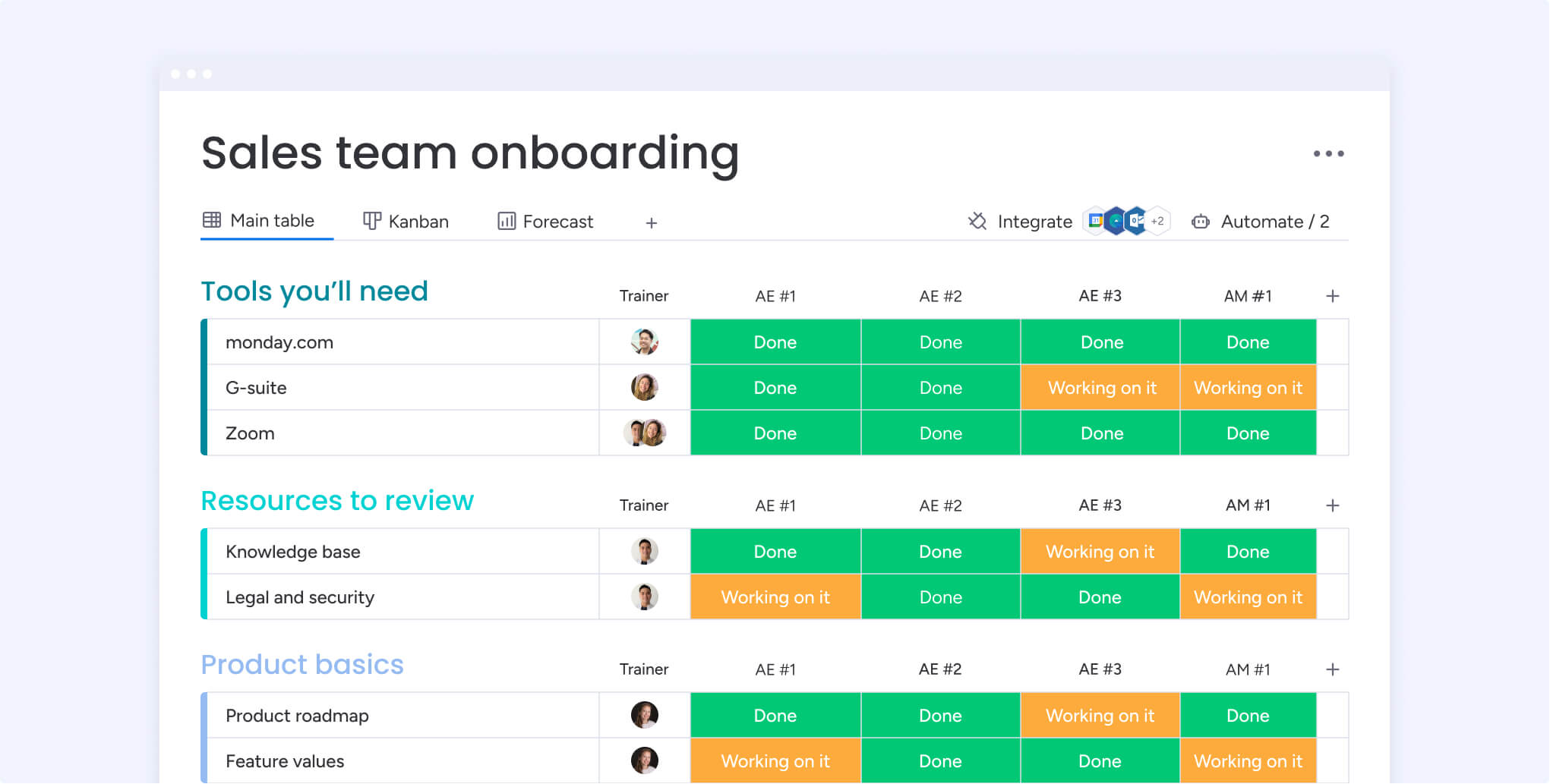
Frequently asked questions
What is sales analytics software used for?
Sales analytics software collects and analyzes sales data to help teams track performance, forecast revenue, and identify opportunities for improvement. It transforms raw data into actionable insights that guide strategic decision-making.
Is sales analytics software the same as CRM software?
No, sales analytics software focuses on data analysis, while CRM software manages customer relationships and sales processes. Many modern CRM platforms, like monday CRM, now include powerful built-in analytics capabilities.
Do small businesses need dedicated sales analytics platforms?
Yes, sales analytics platforms help small businesses make data-driven decisions to compete more effectively. They provide crucial insights that help small teams maximize their impact, even with limited resources.
What is the best sales analytics software for predictive forecasting?
The best software combines historical data with AI to predict future sales outcomes. Look for platforms that offer robust forecasting that is accessible and actionable for your entire team.
Can sales analytics software integrate with existing CRM systems?
Most sales analytics platforms can integrate with CRM systems, but this can create data silos. An all-in-one platform with native analytics eliminates technical complexity and provides a single source of truth.
How much does sales analytics software typically cost?
Pricing varies widely based on features, user count, and deployment model. Plans can range from free basic tiers to enterprise solutions costing several hundred dollars per user monthly.
 Get started
Get started 


